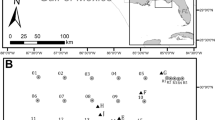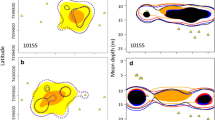Abstract
The spatially explicit diel movement patterns of fish using coral reef ecosystems are not well understood, despite the widespread recognition that many common species undergo distinct migrations to utilize different resources during night and day. We used manual acoustic telemetry coupled with global positioning technology to track the detailed spatially explicit daily movements (24 h) of multiple individuals of two common Caribbean fish species, Haemulon sciurus (bluestriped grunt) and Lutjanus apodus (schoolmaster snapper). Movement pathways and day and night activity spaces were mapped and quantified in a Geographic Information System (GIS). Directional sun-synchronous migrations occurred close to astronomical sunset and sunrise. Site fidelity within day and night activity spaces was high. Nine of twelve individuals exhibited overlap of day and night activity spaces and three fish (L. apodus) exhibited complete spatial segregation. Night activity spaces (H. sciurus: 11,309 ± 3,548 m2; L. apodus: 9,950 ± 3,120 m2) were significantly larger than day activity spaces (H. sciurus: 2,778 ± 1,979 m2; L. apodus: 1,291 ± 636 m2). The distance between sequential position fixes (step lengths) was significantly greater at night than day, indicative of nocturnal foraging and day resting behavior. Integrating acoustic telemetry, GIS techniques and spatial statistics to study fish movement behavior revealed both individual variability and some broader generality in movement paths and activity spaces suggestive of complex underlying behavioral mechanisms influencing diel movements.




Similar content being viewed by others
References
Beets J, Muehlstein L, Haught K, Schmitges H (2003) Habitat connectivity in coastal environments: patterns and movements of Caribbean coral reef fishes with emphasis on bluestriped grunt, Haemulon sciurus. Gulf Caribb Res 14:29–42
Bell WJ, Kramer E (1979) Search and anemotactic orientation of cochroaches. J Insect Physiol 25:631–640
Beyer HL (2004) Hawth's Analysis Tools for ArcGIS (version 9/18/2007). http://www.spatialecology.com/htools
Bradshaw CJA, Sims DW, Hays GC (2007) Measurement error causes scale-dependent threshold erosion of biological signals in animal movement data. Ecol Appl 17:628–638
Burke NC (1995) Nocturnal foraging habitats of French and bluestriped grunts, Haemulon flavolineatum and H. sciurus, at Tobacco Caye, Belize. Environ Biol Fish 42:365–374
Childs A-R, Booth AJ, Cowley PD, Potts WM, Næsje TF, Thorstad EB, Økland F (2008) Home range of an estuarine-dependent fish species Pomadasys commersonnii in a South African estuary. Fish Mgmt Ecol 15:441–448
Clark RD, Pittman S, Caldow C, Christensen J, Roque B, Appeldoorn RS, Monaco ME (2009) Nocturnal fish movement and trophic flow across habitat boundaries in a coral reef ecosystem (SW Puerto Rico). Carib J Sci 45(2-3):282–303
Claydon J (2004) Spawning aggregations of coral reef fishes: characteristics, hypotheses, threats and management. Ocean Mar Biol Ann Rev 42:265–302
Cocheret de la Morinière E, Pollux BJA, Nagelkerken I, Hemminga MA, Huiskes AHL, van der Velde G (2003a) Ontogenetic dietary changes of coral reef fishes in the mangrove-seagrass-reef continuum: stable isotopes and gut-content analysis. Mar Ecol Prog Ser 246:279–289
Cocheret de la Morinière E, Pollux BJA, Nagelkerken I, van der Velde G (2003b) Diet shifts of Caribbean grunts (Haemulidae) and snappers (Lutjanidae) and the relation with nursery-to-coral reef migrations. Est Coast Shelf Sci 57:1079–1089
Cushman SA (2009) Animal movement data: GPS telemetry, autocorrelation and the need for path-level analysis. In: Cushman SA, Huettmann F (eds) Spatial complexity, informatics, and wildlife conservation. Springer, New York, pp 131–149
Dahlgren CP, Eggleston DB (2000) Ecological processes underlying ontogenetic habitat shifts in a coral reef fish. Ecology 81:2227–2240
DeLaune MG (2000) XTools ArcMap Extension (Version 10/18/2000). http://www.xtoolspro.com
Dubin RE, Baker JD (1982) Two types of cover-seeking behavior at sunset by the princess parrotfish, Scarus taeniopterus, at Barbados, West Indies. Bull Mar Sci 32:572–583
Getz WM, Saltz D (2008) A framework for generating and analyzing movement paths on ecological landscapes. Proc Nat Acad Sci 105:19066–19071
Gladfelter WB (1979) Twilight migrations and foraging activities of the copper sweeper Pempheris schomburgki (Teleostei: Pempheridae). Mar Biol (Berl) 50:109–119
Halpin PM (2000) Habitat use by an intertidal salt-marsh fish: trade-offs between predation and growth. Mar Ecol Prog Ser 198:203–214
Hammerschlag N, Heithaus MR, Serafy JE (2010a) Influence of predation risk and food supply on nocturnal fish foraging distributions along a mangrove-seagrass ecotone. Mar Ecol Prog Ser 414:223–235
Hammerschlag N, Morgan AB, Serafy JE (2010b) Relative predation risk for fishes along a subtropical mangrove-seagrass ecotone. Mar Ecol Prog Ser 401:259–267
Helfman GS, Meyer JL, McFarland WN (1982) The ontogeny of twilight migration patterns in grunts (Pisces: Haemulidae). Anim Behav 30:317–326
Hitt S, Pittman SJ, Nemeth RS (2011) Fish movement behavior is linked to benthic seascape structure in a Caribbean coral reef ecosystem. Mar Ecol Prog Ser 427: 275–291
Hobson ES (1973) Diel feeding migrations in tropical reef fishes. Helgoländer wiss Meeresunters 24:361–370
Kramer DL, Chapman MR (1999) Implications of fish home range size and relocation for marine reserve function. Environ Biol Fish 55:65–79
Krumme U (2009) Diel and tidal movements by fish and decapods linking tropical coastal ecosystems. In: Negelkerken I (ed) Ecological connectivity among tropical coastal ecosystems. Springer, New York, pp 271–324
Laver P (2005) ABODE: kernel home range estimation for ArcGIS, using VBA and ArcObjects. User manual (Beta v. 2–7)
Lowe CG, Topping DT, Cartamil DP, Papastamatiou YP (2003) Movement patterns, home range, and habitat utilization of adult kelp bass Paralabrax clathratus in a temperate no-take marine reserve. Mar Ecol Prog Ser 256:205–216
McFarland WN, Ogden JC, Lythgoe JN (1979) The influence of light on the twilight migrations of grunts. Environ Biol Fish 4:9–22
McKibben JN, Nelson DR (1986) Patterns of movement and grouping of gray reef sharks, Carcharhinus amblyrhynchos, at Enewetak, Marshall Islands. Bull Mar Sci 38:89–110
Meyer CG, Holland KN, Wetherbee BM, Lowe CG (2000) Movement patterns, habitat utilization, home range size and site fidelity of whitesaddle goatfish, Parupeneus porphyreus, in a marine reserve. Environ Biol Fish 59:235–242
Meyer JL, Schultz ET, Helfman GS (1983) Fish schools: an asset to corals. Science 220:1047–1049
Meyer JL, Schultz ET (1985) Migrating haemulid fishes as a source of nutrients and organic matter on coral reefs. Limnol Ocean 30:146–156
Monaco ME, Friedlander AM, Caldow C, Christensen JD, Rogers C, Beets J, Miller J, Boulon R (2007) Characterizing reef fish populations and habitats with and outside the US Virgin Islands Coral Reef National Monument: a lesson in marine protected area design. Fish Mgmt Ecol 14:33–40
Morrissey JF, Gruber SH (1993) Home range of juvenile lemon sharks, Negaprion brevirostris. Copeia 1993:425–434
Nagelkerken I, Dorenbosch M, Verberk WCEP, Cocheret de la Morinière E, van der Velde G (2000) Day–night shifts of fishes between shallow-water biotopes of a Caribbean bay, with emphasis on the nocturnal feeding of Haemulidae and Lutjanidae. Mar Ecol Prog Ser 194:55–64
Nathan R, Getz WM, Revilla E, Holyoak M, Kadmon R, Saltz D, Smouse PE (2008) A movement ecology paradigm for unifying organismal movement research. Proc Natl Acad Sci 105:19052–19059
Ogden JC, Buckman NS (1973) Movements, foraging groups, and diurnal migrations of the striped parrotfish Scarus croicensis Bloch (Scaridae). Ecology 54:589–596
Ogden JC, Ehrlich PR (1977) The behaviour of heterotypic resting schools of juvenile grunts (Pomadasyidae). Mar Biol 42:273–280
Ogden JC, Zieman JC (1977) Ecological aspects of coral reef-seagrass bed contacts in the Caribbean. In: Proc 3rd Int Symp Coral Reefs, (1, Biology), pp 377–382
Ortega LA, Heupel MR, van Beynen P, Motta PJ (2009) Movement patterns and water quality preferences of juvenile bull sharks (Carcharhinus leucas) in a Florida estuary. Environ Biol Fish 84:361–373
Otis DL, White GC (1999) Autocorrelation of location estimates and the analysis of radio tracking data. J Wildl Manag 63:1039–1044
Paddack MJ, Reynolds JD, Aguilar C, Appeldoorn RS, Beets J, Burkett EW, Chittaro PM, Clarke K, Esteves R, Fonseca AC, Forrester GE, Friedlander AM, García-Sais J, González-Sansón G, Jordan LKB, McClellan DB, Miller MW, Molloy PP, Mumby PJ, Nagelkerken I, Nemeth M, Navas-Camacho R, Pitt J, Polunin NVC, Reyes-Nivia MC, Robertson DR, Rodríguez-Ramírez A, Salas E, Smith SR, Spieler RE, Steele MA, Williams ID, Wormald CL, Watkinson AR, Côté IM (2009) Recent region-wide declines in caribbean reef fish abundance. Curr Biol 19:590–595
Papastamatiou YP, Lowe CG, Caselle JE, Friedlander AM (2009) Scale-dependent effects of habitat on movements and path structure of reef sharks at a predator-dominated atoll. Ecology 90:996–1008
Pittman SJ, McAlpine CA (2003) Movement of marine fish and decapod crustaceans: process, theory and application. Adv Mar Biol 44:205–294
Pittman SJ, Caldow C, Hile SD, Monaco ME (2007) Using seascape types to explain the spatial patterns of fish in the mangroves of SW Puerto Rico. Mar Ecol Prog Ser 348:273–284
R_Development_Core_Team (2010) R: A language and environment for statistical computing. R Foundation for Statistical Computing, Vienna
Reese ES (1989) Orientation behavior of butterflyfishes (family Chaetodontidae) on coral reefs: spatial learning of route specific landmarks and cognitive maps. Environ Biol Fish 25:79–86
Rillahan C, Chambers M, Howell WH, Watson WH III (2009) A self-contained system for observing and quantifying the behavior of Atlantic cod, Gadus morhua, in an offshore aquaculture cage. Aquaculture 293:49–56
Robblee MB, Zieman JC (1984) Diel variation in the fish fauna of a tropical seagrass feeding ground. Bull Mar Sci 34:335–345
Rooker JR (1995) Feeding ecology of the schoolmaster snapper, Lutjanus apodus (Walbaum), from southwestern Puerto Rico. Bull Mar Sci 56:881–894
Rooker JR, Dennis GD (1991) Diel, lunar and seasonal changes in a mangrove fish assemblage off southwestern Puerto Rico. Bull Mar Sci 49:684–698
Sale PF, Cowen RK, Danilowicz BS, Jones GP, Kritzer JP, Lindeman KC, Planes S, Polunin NVC, Russ GR, Sadovy YJ, Steneck RS (2005) Critical science gaps impede use of no-take fishery reserves. Trends Ecol Evol 20:74–80
Stallings CD (2009) Fishery-independent data reveal negative effect of human population density on Caribbean predatory fish communities. PLoS One 4:e5333
Stark WA II, Davis WP (1966) Night habits of fishes of Alligator Reef, Florida. Ichthyol Aquarium J 38:313–356
Tolimieri N, Andrews K, Williams G, Katz S, Levin PS (2009) Home range size and patterns of space use by lingcod, copper rockfish and quillback rockfish in relation to diel and tidal cycles. Mar Ecol Prog Ser 380:229–243
Topping DT, Lowe CG, Caselle JE (2005) Home range and habitat utilization of adult California sheephead, Semicossyphus pulcher (Labridae), in a temperate no-take marine reserve. Mar Biol 147:301–311
Tulevech SM, Recksiek CW (1994) Acoustic tracking of adult white grunt, Haemulon plumierii, in Puerto Rico and Florida. Fish Res 19:301–319
Turchin P (1998) Quantitative analysis of movement: measuring and modeling population redistribution in individuals and plant. Sinauer Associates, Sunderland
Verweij MC, Nagelkerken I (2007) Short and long-term movement and site fidelity of juvenile Haemulidae in back-reef habitats of a Caribbean embayment. Hydrobiologia 592:257–270
Verweij MC, Nagelkerken I, Hol KEM, van den Beld AHJB, van der Velde G (2007) Space use of Lutjanus apodus including movement between a putative nursery and a coral reef. Bull Mar Sci 81:127–138
Acknowledgements
This research was supported by a NOAA cooperative agreement with the University of the Virgin Islands. We thank the staff of NOAA’s Biogeography Branch for providing logistical support and acoustic tracking equipment and the National Park Service on St. John for their cooperation while operating within the Virgin Islands National Park. We would also like to thank the numerous UVI volunteers who helped to collect the 288 h of fish tracking data in all weather conditions. Finally, we would like to extend our gratitude to the anonymous reviewers of this manuscript for their constructive comments.
Author information
Authors and Affiliations
Corresponding author
Rights and permissions
About this article
Cite this article
Hitt, S., Pittman, S.J. & Brown, K.A. Tracking and mapping sun-synchronous migrations and diel space use patterns of Haemulon sciurus and Lutjanus apodus in the U.S. Virgin Islands. Environ Biol Fish 92, 525–538 (2011). https://doi.org/10.1007/s10641-011-9875-2
Received:
Accepted:
Published:
Issue Date:
DOI: https://doi.org/10.1007/s10641-011-9875-2




